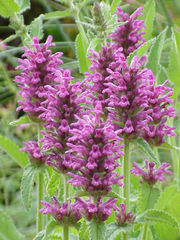Stachys
| Stachys subsp. var. | Betony, Hedge nettle, Woundwort | |||||||||||||||||||||||||||||||||||||||||||||||||||||||
|---|---|---|---|---|---|---|---|---|---|---|---|---|---|---|---|---|---|---|---|---|---|---|---|---|---|---|---|---|---|---|---|---|---|---|---|---|---|---|---|---|---|---|---|---|---|---|---|---|---|---|---|---|---|---|---|---|

|
|
| ||||||||||||||||||||||||||||||||||||||||||||||||||||||
| ||||||||||||||||||||||||||||||||||||||||||||||||||||||||
- For the botanical term, see Stachys (term)
Stachys is a genus of about 300 species of annual and perennial herbaceous plants and shrubs in the family Lamiaceae. The distribution of the genus covers Europe, Asia, Africa, Australasia and North America. Common names include heal-all, self-heal, woundwort, betony, lamb's ears, and hedgenettle. Wood betony, Stachys officinalis, was the most important medicinal herb to the Anglo-Saxons of early medieval Britain.
The stems vary from 50-300 cm tall, with simple, opposite triangular leaves 1-14 cm long with serrated margins; in most species the leaves are softly hairy. The flowers are 1.2 cm long, clustered in the axils of the leaves on the upper part of the stem, the corolla 5-lobed with the top lobe forming a 'hood', varying from white to pink, purple, red or pale yellow.
In Europe, stachys can be found growing in wastelands, grasslands and woodland edges. All-heal thrives in any damp soil in full sun or in light shade. Plants are apt to become troublesome weeds in turf that is at all damp. Sow seed in very early spring in a flat outdoors, or give a short cold and moist conditioning treatment before sowing in a warm place. Growing from 1 to 2 feet high, with creeping, self-rooting, tough, square, reddish stems branching at leaf axis. The leaves are lance shaped, serrated and reddish at tip, about an inch long and 1/2 inch broad, grow on short stalks in opposite pairs down the square stem. The flowers grow from a clublike, somewhat square, whirled cluster, immediately below this club are a pair of stalkless leaves standing out on either side like a collar. Flowers are two lipped and tubular, the top lip is a purple hood, and the bottom lip is often white, it has three lobes with the middle lobe being larger and fringed upwardly. Flowers bloom at different times depending on climate and other conditions. Mostly from June to August. Gather whole plant when flowers bloom, dry for later herb use. Leaves and small flowers are edible.
| Standard Cyclopedia of Horticulture |
|---|
|
Stachys (from an old Greek name applied by Dioscorides to another group of plants, coming from the word for spike). Labiatae. Woundwort. Tall perennial herbs or diffuse annuals, rarely subshrubs or small shrubs, both greenhouse and hardy plants, little known to gardeners. Leaves very entire or dentate, the floral lvs. similar or reduced to bracts: floral whorls 2- to many-fld., axillary or arranged in terminal spikes: fls. sessile or very short-pedicelled, purplish, scarlet, pale yellow, or white, small or sometimes showy; calyx tubular-campanulate, 5-10-nerved, 5-toothed; corolla-tube cylindrical, included or exserted, limb 2-lipped, the posterior often villous outside; stamens 4: nutlets ovoid or oblong.—About 270 species, mainly in the temperate regions but a few in the tropical and colder regions, scattered all over the world. The arrangement followed in the sections and sequence of species is that of Briquet in Engler & Prantl, Pflanzenfamilien, IV. 3a:260. Very few of the species are cult., although there are several with showy spikes. They are usually found in moist or even wet places when growing wild. A tuber-bearing species (S. Sieboldii) has come into notice as a kitchen-garden plant. Betonica carnea, Hort., is offered in the trade, probably a flesh-colored form of S. grandiflora.—Betonica rubra, Hort., is also in the trade, probably a red-fld. form of S. grandiflora. CH
|
Cultivation
Propagation
Pests and diseases
Species
Selected species ==
Gallery
References



